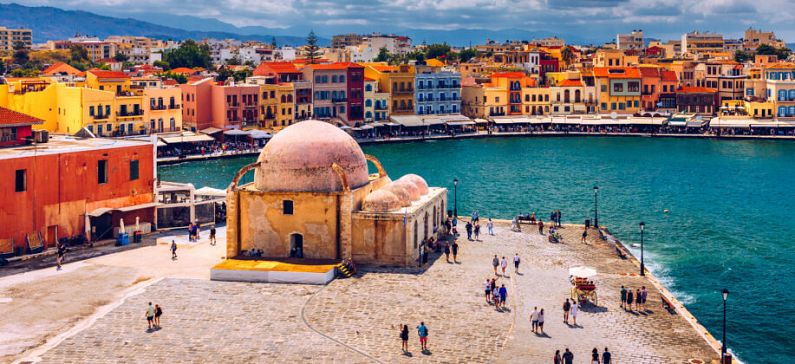
Ten secrets you need to know
When you hear or read about Chania, usually your mind travels to the picturesque port, the unique beaches of the prefecture, Elafonissi, the unique sunset in Falassarna, the wild beauty of the landscape in Seitan Port.
What fewer people know for sure are the secrets of the town and the prefecture. A city whose history dates back to the Neolithic era. A city that was a very important city-state in the Minoan era, with boundaries from the sea to the foot of the White Mountains. Along the way, the Byzantine era, the Venetian period and the Ottoman period passed over it, after a two-month siege to bring down its walls.
1. Big arsenal
The largest of the stone-built naves in the old port of Chania, the Great Arsenal, built in 1600, dominates, recalling the glories of the Venetian times, when it was the seat of the Venetian flagship. In later years, it hosted the school of the Christian community, housed theatrical performances, functioned as a municipal hospital, while in the period 1928-1941 it was the town hall of the city. The bombing of Chania during the Second World War destroyed it to such an extent that extensive reconstruction work was necessary to make it usable again. Today it houses the Centre for Mediterranean Architecture, as a multi-purpose venue for cultural events, conferences, seminars, workshops, exhibitions, concerts and small-scale theatre performances.
2. Angelou Street
Next to the Maritime Museum, in the northwest of the Old Town, we find Angelou Street. A picturesque street in which you can find Venetian mansions, houses from the Ottoman period, but also brand new boutique hotels that win over the unsuspecting traveller at first sight. This small street with its intense cultural history is special for its two preserved Venetian buildings, as well as for the tallest (five-storey) stone Turkish building in the harbour. Angelou Street, over the years, has been a hangout for artists and has been featured hundreds of times on social media.
3. Stivania
The street Skrydlof Street looks like a street out of the dustbin of history. There, also known as Stivanadika, were the old cobblers’ workshops, which may have given way to tourist shops, but among the countless stalls and all kinds of local products, there is a traditional shop, Lefteris’ cobbler’s shop. One of the last authentic craftsmen, he has been manufacturing with passion for 65 years durable leather Cretan boots in all sizes, made to order.
4. Garden
Tucked away in the lush municipal gardens of Chania, the historic Garden Cafe has become one of Chania’s most charming meeting places. Old handmade furniture, chairs made in France, vintage objects and a touch of nostalgia travel our mood to another era, to the cafes of Vienna and Paris. Its history began in 1936, went through its golden age in the 1950s and 1960s and on 9 April 1988, Vassilis Stathakis, who had worked until then, took over and gave it new life, always respecting tradition. It maintains its cultural identity, hosting exhibitions, literary and culinary festivals and last year a unique exhibition of rare vintage photographs of Chania.
5. Classic Motorcycle Club
Since 1999, classic motorcycle enthusiasts in Chania have had their own club, giving people of all ages the opportunity to enjoy the beauty of Crete in a different way: combining speed and what only these two-wheelers can offer a sense of independence and nostalgia. Their guided tours usually take place on Sundays. The members of the Classic Motorcycle Club of Chania have many stories to tell!
6. Artistic Village “Verekynthos”
At the foot of Mount Verekynthos, between Souda and Tsikalaria, there is an artistic village of the same name. It was no coincidence that this place was chosen, since the traditionally ideal Dactylos, son of Zeus and patron of the arts, came here to teach people how to live and worship metalworking, ceramics, glassmaking and weaving. Thus, art, inextricably linked to Cretan culture and civilization, once again takes its rightful place in this village of 28 workshops.
7. Monastery of Agia Triada
The largest and most imposing monastery of the prefecture is the Holy Trinity of Mourtara or Tzagarolon, located 16 km northeast of the city of Chania. Decorated with Doric columns, the entrance facade is a distinctive feature, while north of the central entrance is a museum with exhibits from the 1821 Revolution. The production of olive oil and organic wine, under the name “Monastiriakos Oinos-Agias Triada”, which are available throughout Greece, is also excellent.
8. Drosoulites
In the famous Fragokastello, the imposing Venetian castle of 1370 near Sfakia in the south of the island, has its own legend. The Drosoulites. There, every year, at dawn on 18 May, legend and local lore have it that in the morning dew, black-robed humanoid shadows with swords and helmets appear, seemingly heading, on horseback or on foot, towards the ruined church of Aghios Charalambos, near the castle. The myth begins with the battle of 1828 between the Turkish soldiers and the warriors of the chieftain Hadjimichalis Dalianis, but it is of little importance now whether it is a simple mirage phenomenon with a scientific explanation or not.
9. Tambakaria
One of the most important craft centres of the 19th century in Crete emerges in the eastern, rocky area of Chania, below the “first-class” Halepa. Tabakaria are now abandoned lifeless carcasses of a flourishing industrial past. At one time, hundreds of skilled craftsmen worked in the tanneries, which were mainly prominent in the inter-war period. The reasons for choosing the area were that there was abundant underground brackish water, next to a shallow sea, which was useful for the first stage of leather processing.
10. Byzantine and post-Byzantine collection
The rich archaeological material constituted a collection which records the history of the westernmost prefecture of Crete from early Christian times to the Ottoman period. Representative examples are on display in the Franciscan church of San Salvatore (15th-17th century).







